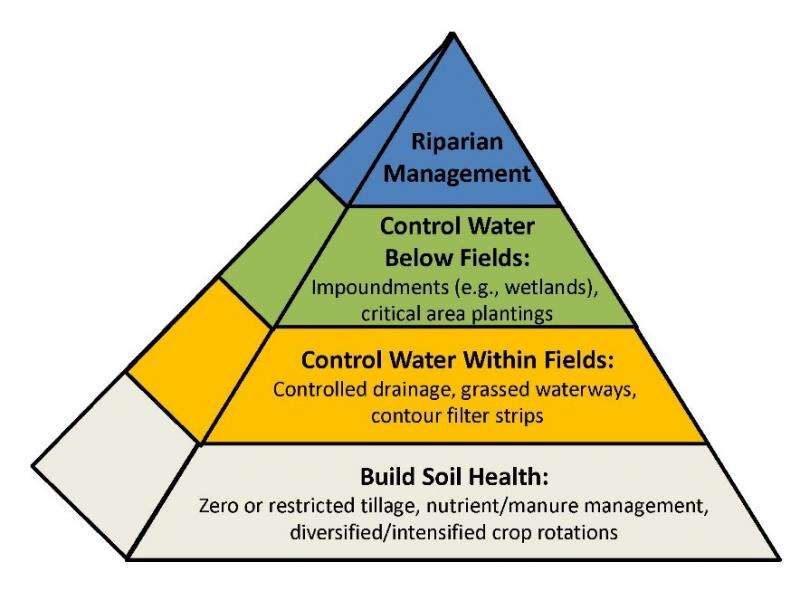New planning toolset gives farmers more options for improving water quality

With agriculture increasingly on the hook to improve water quality, curb erosion, and meet other environmental goals, it only makes sense to target soil and water conservation practices to the places on the landscape where they'll do the most good. Exactly how to achieve this is the catch, but a promising new solution is now at the ready, thanks to research led by the USDA-Agricultural Research Service (USDA-ARS) and Environmental Defense Fund.
Writing in the current issue of the Journal of Environmental Quality, the team describes its Agricultural Conservation Planning Framework (ACPF): a systematic approach to identifying the best options for reducing nutrient losses and erosion within a watershed—whether those opportunities exist in farm fields, along stream banks, or in other locations.
Its roots lie in "precision conservation," the idea of selecting the right conservation practice and placing it where it will be most effective, says lead author Mark Tomer, a USDA-ARS scientist in Iowa. However, while most attempts at this focus on one practice at a time, the ACPF looks at several. The result is an entire inventory of conservation possibilities, from which farmers and other stakeholders within a watershed can choose their preferred options and even map out a strategy together.
That's important, because as water quality continues to decline in Lake Erie, the Gulf of Mexico, and other locations, people are realizing the need both for a mix of practices and a concerted push.
"These problems are continental in scope, but addressing them involves the management of thousands of small agricultural watersheds and millions of individual farm fields," Tomer says. "So I think providing for a coordinated effort among farmers and others to address water quality is really key."
Building the framework
Excess nutrients flowing from agricultural watersheds affect water quality in several ways. Nitrogen and phosphorus contribute to algal blooms and areas of oxygen-starved, or "hypoxic," zones in downstream water bodies. High nitrate levels also make water unfit for drinking.
But the measures farmers can take to address these problems aren't always apparent. Moreover, while most farmers already engage in conservation, says Tomer, they often only target the most obvious problems on their own lands, such as erosion.
To build on those individual efforts, Tomer and the team began their research in 2012 by creating criteria for siting conservation practices in a suite of optimal locations within a watershed. The criteria are based on information like soil type and land use, and the presence of tile drainage. But what really makes them possible are extremely detailed, topographic maps derived from LiDAR surveys of the ground surface. So fine is the resolution, says Tomer, the technology even allows the height of stream banks to be estimated.
While producing the siting criteria was a critical step, however, the group soon realized this wasn't terribly useful on its own. "We ended up with a list of practices with no flow or overarching concept to guide decisions about their use," Tomer says. That's where the framework comes in.
The framework is basically a pyramid, he explains, with cover crops and other crucial soil management practices at its base. The next level up focuses on options for curbing runoff and nutrient losses within farm fields: Which fields, for example, are most suited to controlled drainage systems or grassed waterways?
Next, the ACPF pinpoints the prime spots for conservation practices outside of fields (nutrient removal wetlands, for instance). And, lastly, it identifies the prospects for reducing both surface and subsurface losses of nutrients and sediments along stream and river corridors.
"So you can think of it as a continuum of opportunities," Tomer says, starting with essential soil health practices that every farmer wants to use, and moving up to more specialized—and, sometimes, more expensive—technologies that should be installed only where they'll give the most benefit.
Impacts on production
Something else users can calculate is how much cropland will need to come out of production to make way for conservation installations. In the work in JEQ, the researchers sited locations for four practices in two test watersheds in Iowa and Illinois, creating different combinations of the techniques across the landscape, called scenarios. For each scenario, they then asked how many farm acres would have to be sacrificed to meet their chosen water quality target: the Iowa Nutrient Reduction Strategy goal of a 40% drop in nitrogen.
In both watersheds they found the target could be feasibly met at the expense of just 3-4% of total cropland. Plus, the ACPF asks whether practices can be placed in sequence, taking the pressure off any single approach to improve water quality. "So if you've got several different practices, they're well-distributed around the watershed, and they don't take a lot of land out of production, you should have something farmers can live with," Tomer says.
At the same time, the ACPF results are never prescriptive, he adds. Instead, they're meant to spark discussion and collaboration. "I think the most important thing about this," he says, "is that it's a way to help farmers understand their options."
More information: View the two open access JEQ papers describing the ACPF:
www.agronomy.org/publications/ … q/abstracts/44/3/754
www.agronomy.org/publications/ … q/abstracts/44/3/768
Journal of Environmental Quality DOI: 10.2134/jeq2014.09.0386
Journal information: Journal of Environmental Quality
Provided by American Society of Agronomy




















